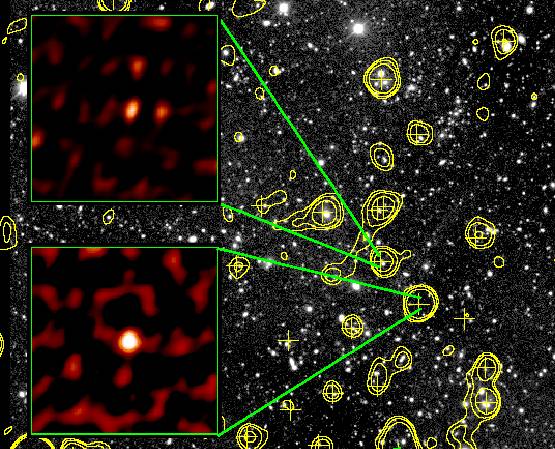Explanation: Radio waves, like visible light, are electromagnetic radiation and radio telescopes can "see" -- their signals translated into radio images of the cosmos. While individually even the largest radio telescopes have very blurry vision compared to their optical counterparts, networks of radio telescopes can combine signals to produce sharper pictures. In fact, using a supercomputer in New Mexico, USA and technique called VLBI (Very Long Baseline Interferometry), the European network of radio telescopes (EVN) have produced pictures of distant galaxies at a resolution some three times higher than the Hubble Space Telescope. Pentrating obscuring dust, the false-color EVN radio images are inset above according to their relative location in an optical image of the famous Hubble Deep Field region of the sky. (Yellow lines superimposed on the optical image are radio intensity contours from a single telescope) The bright cosmic radio source in the middle of each inset corresponds to a galaxy. Impressively, the radio sources appear to be so small, less than about 600 light-years across in actual size, that they are thought to be associated with massive central black holes in the distant deep field galaxies.
1999 2000 2001 2002 2003 2004 2005 2006 2007 2008 2009 2010 2011 2012 2013 2014 2015 2016 2017 2018 2019 2020 2021 2022 2023 2024 2025 |
Yanvar' Fevral' Mart Aprel' Mai Iyun' Iyul' Avgust Sentyabr' Oktyabr' Noyabr' Dekabr' |
NASA Web Site Statements, Warnings, and Disclaimers
NASA Official: Jay Norris. Specific rights apply.
A service of: LHEA at NASA / GSFC
& Michigan Tech. U.
|
Publikacii s klyuchevymi slovami:
chernye dyry - black hole - Radioteleskop - radiotelescope - Hubble Deep Field - Habblovskie oblasti glubokogo obzora - Skoplenie galaktik
Publikacii so slovami: chernye dyry - black hole - Radioteleskop - radiotelescope - Hubble Deep Field - Habblovskie oblasti glubokogo obzora - Skoplenie galaktik | |
Sm. takzhe:
Vse publikacii na tu zhe temu >> | |
